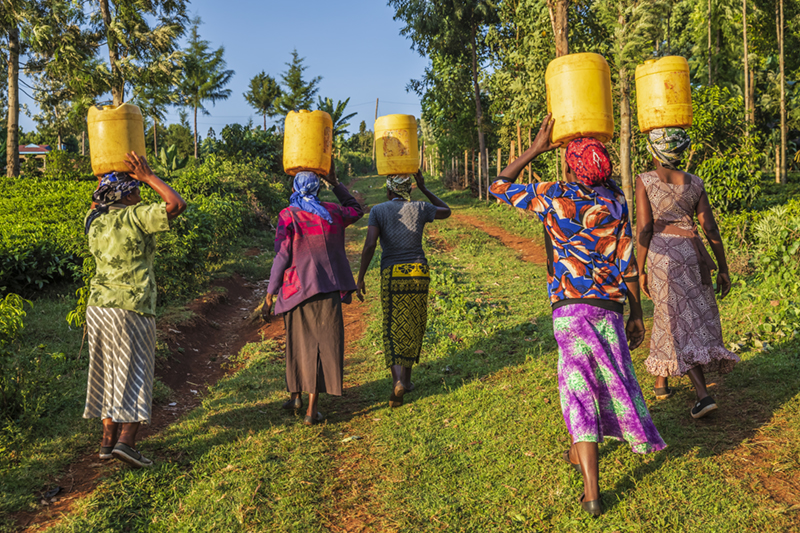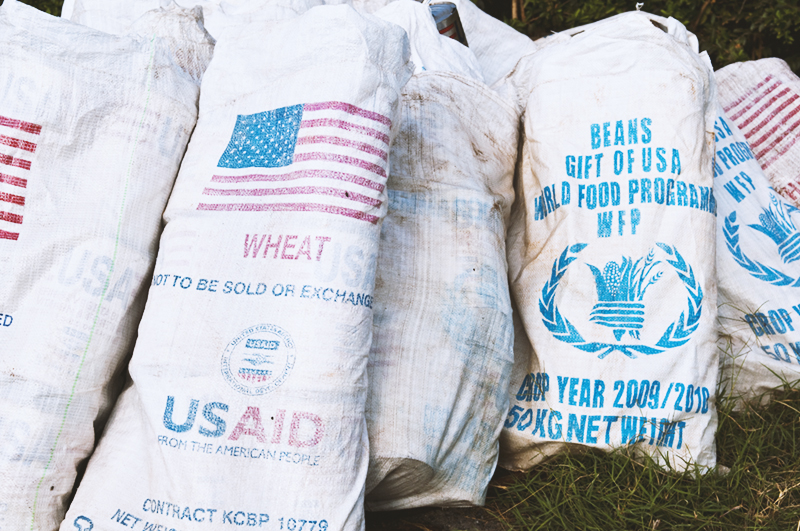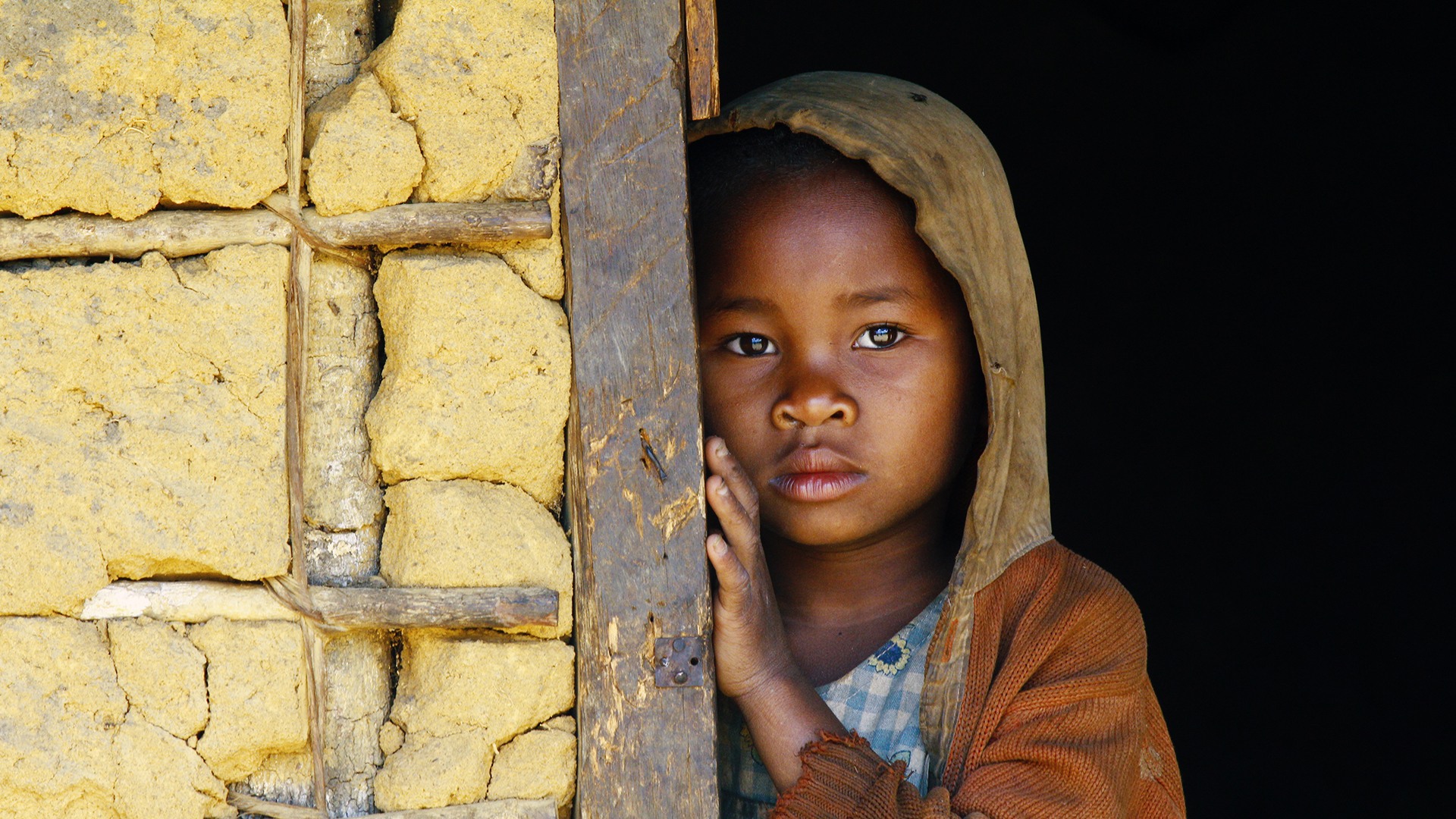Will the Poor Always Be With Us?
Foreign Aid as an Anti-Poverty Tool
Some aid projects are successful while others do more harm than good. What makes the difference?
“End poverty in all its forms everywhere.” The United Nations proclaimed this lofty goal in 2015, and while we can easily get behind such a mission, many question whether it’s achievable.
The issue came to the fore in the autumn of 2021. The convergence of multiple crises including the COVID-19 pandemic, rampant unemployment, and effects of climate change led to widespread famine in many nations. Raising awareness of the crisis, David Beasley, executive director of the United Nations World Food Programme, appealed to the world’s billionaires, noting that just 2 percent of their wealth (or US$6 billion) would help 42 million people avoid starvation. In his call to action, Beasley specifically named the ultra-rich Jeff Bezos (founder and executive chair of Amazon) and Elon Musk (cofounder and CEO of Tesla and SpaceX).
In response, Musk tweeted an agreement to donate, on one condition: he first wanted the UN to show how $6 billion would solve the problem. Beasley complied, elaborating how the money would be used; but the UN World Food Programme never received the requested funding. A year later, in October 2022, Musk bought Twitter for $44 billion.
While many might debate the motive behind Musk’s tweet to Beasley, the development industry itself has been grappling with the implied question for decades: Is foreign aid effective?
The Birth of Modern Foreign Aid
In centuries past, foreign aid often took the form of military assistance to colonies and other countries deemed strategically important. Today it has broader application, though the effectiveness debate is largely centered around Official Direct Assistance (ODA), or grants and loans directly proffered by one government or multilateral organization to another. ODA represents the bulk of foreign aid between donor and recipient countries. Other types of foreign assistance include humanitarian aid, usually administered during emergencies such as conflict or natural disasters; and charitable aid, which is funded directly from International Non-Governmental Organizations (NGOs). When discussing foreign aid’s effectiveness, it’s usually about ODA, so that will be this article’s focus.
When we think of foreign aid today, we tend to picture basic supplies going to malnourished children in the least developed countries. But perhaps surprisingly, the roots of modern foreign aid lie in preparations for the repair of post-WWII Europe. In 1944–45 the International Bank for Reconstruction and Development (now known as the World Bank) and the International Monetary Fund were established to facilitate reconstruction. In the United States, the Marshall Plan of 1948 committed to distributing a colossal US$13 billion (well over $100B in today’s currency) to 17 European countries.
By the 1960s the aid industry started to take shape. Many governments created their own agencies to manage the increasingly large distribution of funds abroad, among them the United States Agency for International Development (USAID), Germany’s Gesellschaft für Internationale Zusammenarbeit (GIZ) and the United Kingdom’s Ministry of Overseas Development, now known as the Foreign Commonwealth and Development Office (FCDO). Also in the ’60s, the Paris-based intergovernmental Organisation of Economic Cooperation and Development (OECD) formed; it continues to track and influence ODA.
Top Five OECD Donor Countries in 2021
- United States: US$42.31B
- Germany: US$32.23B
- Japan: US$17.62B
- United Kingdom: US$15.81B
- France: US$15.45B
By almost all accounts, the $13B investment into post-WWII Europe was an overwhelming success. Western Europe was able to avoid major setbacks and today represents one of the wealthiest regions of the globe. As ODA became interlinked with foreign policy in places beyond WWII reconstruction, however, the results were much more nebulous.
Around this time, the nature of international relations was experiencing a fundamental change. Colonialism as a facet of foreign policy began to retreat as many colonies gained independence—17 sub-Saharan African nations in 1960 alone. Based on the success of the Marshall Plan, formal ODA became a preferred mechanism for fighting global poverty, but it was also a way of exerting continued influence abroad. For example, when USAID was established in the 1960s, its stated intentions were to create markets for the United States by creating growth in lesser developed countries and simultaneously to promote capitalism (thus disempowering communist governments). ODA was always meant to benefit the donor country in addition to addressing needs in the recipient country.
“Foreign aid is used predominantly to promote geostrategic interests, for the right to build and maintain foreign bases, to strengthen alliances, or to keep allied regimes in power.”
Making the World a Safer Place
According to economists Wolfgang Fengler and Homi Kharas, from 1960 to 2008 rich countries delivered an estimated $3.2 trillion to developing countries to eradicate poverty. More recently, reports the World Economic Forum, nations spent a record $161.2B on aid in 2020 alone (in part to help address the COVID-19 pandemic).
As a researcher-writer on international poverty and human rights, Jonathan Glennie cheekily notes in The Trouble With Aid, “Africa is poor. If rich countries send it money, it will be less poor, and people living in poverty will be better off. It seems perfectly logical, doesn’t it?”
Although Glennie’s comment is firmly tongue-in-cheek, poverty is fundamentally a lack of resources, so an influx of resources can and must be part of the solution. Providing that kind of help to those in the greatest need has certainly provided some real benefits.
Kindo Aïssata, for example, of Côte d’Ivoire, is a beneficiary of a USAID project that trained community members to advocate for delivery of clean drinking water. Like all residents in her town, she and her children had walked as much as 30 km (more than 18 miles) every other day to retrieve water from a fountain. In 2011, during a time of political instability, the trek to the fountain became too dangerous and they were forced to collect water from a nearby marsh.

Women carry containers of water back to their village in Kenya. Women and children in impoverished regions of Africa often walk great distances to obtain potable water for their families.
Aïssata recalls, “At that time, practically every other child suffered from this illness [schistosomiasis, or bilharziasis] because we all supply ourselves from the same source.” Schistosomiasis caused severe indigestion and meant increased costs for medicine and missed time at work or school. Empowered after her USAID training, Aïssata approached the local government-run water delivery company and was able to coordinate water deliveries to her town. Since the delivery service started, there have been no cases of schistosomiasis.
This is not a unique story. When organizations send aid to some of those in greatest need, a little bit of money injected into an area can have a profound effect. Providing such basic needs as access to clean water, sanitation, education and mosquito nets can be lifesaving.
These positive effects should not be discounted. The sheer number of people who have benefited from basic services provided by foreign aid should give us pause.
Mission Accomplished?
USAID reports the following figures to show how many have benefited from some of its aid projects.
Since 2008:
- 59.5 million people gained access to potable water
- 44.6 million people now have access to sustainable sanitation (bathrooms)
In 2019 alone:
- 84 million women and children were supported through access to essential health services
- 94 million people were supplied with life-saving mosquito nets
Well Intended, Poorly Executed
If we consider all the impacts of ODA, however, not everyone agrees that the net benefit has been positive.
For all the good achieved, universal and sustainable economic growth and overall poverty reduction have remained elusive. Part of the reason is that foresight in these types of projects is limited, and unforeseen or unintended consequences can derail well-intended initiatives.
For example, in a 1998 report assessing aid, the World Bank acknowledged that the US$2 billion invested into Tanzania’s road network had almost zero overall impact. Roads often fell into disrepair faster than new roads were completed. Lack of planning for long-term upkeep is one of the most common plagues in ODA projects.
Foreign aid projects don’t lend themselves to solutions that are financially viable in the long term. They are discrete ventures, with clear objectives and a well-defined start and end date. Perhaps it’s reasonable that donors want recipients to manage the upkeep on their own, but in reality, it doesn’t happen (or for various reasons can’t happen). The result is a graveyard of failed or failing infrastructure that helps no one.
Summarizing this problem in her book The Idealist, award-winning journalist Nina Munk writes: “Broken water pumps, half-finished health care clinics, abandoned housing blocks, roads that lead nowhere, dams that have collapsed—Africa is strewn with the remains of well-meaning development projects, Bland [Simon Bland, a 30-year veteran of international development work] pointed out. ‘The problem is,’ he said, ‘when you walk away, what happens?’ Who will fill the potholes and mend the pipes and pit latrines? Who will buy fuel and supply spare parts for the generators?”
“For all the hundreds of billions of dollars spent on foreign aid in the past decades, no one has come close to ending poverty in Africa. Development experts keep . . . promoting one theory after another, but so far there’s been no workable solution.”
Munk recounts the story of a similar lack of foresight during her time in Uganda, when $300,000 was poured into maize development. The farmers indeed ended up with a large maize crop that year, but the market became flooded, ultimately driving the price down. There was nowhere to store the maize, and much of it rotted. While the farmers were overwhelmed with growing and harvesting maize, they neglected their matoke crop—a type of banana and a staple food in the region. The villagers’ disappointment and frustration was understandable; maize, compared with matoke, was difficult to sell, difficult to harvest, and not (from the Ugandan perspective) enjoyable to eat. David Siriri, a Ugandan leader of the project at the time, admitted, “We wasted money on maize seeds and fertilizer. It is money I wish we had not spent.”
The $300,000 investment in an agricultural project certainly held promise. Providing funding to teach new agricultural methods and expand crops and yield can address food insecurity. Clearly, in this case, the project went awry. Ultimately, people felt they would have been better off without it.
Corruption and Politics
These types of mistaken or ill-conceived donor projects are not entirely to blame for all aid inefficiencies, however. One of the main challenges the aid industry faces is corruption in least developed countries. According to Transparency International, an organization that ranks corruption perceptions globally, sub-Saharan Africa received the lowest score of any region—33 out of a possible 100—on the Corruption Perceptions Index.
Dambisa Moyo, a noted Zambian-born economist, argues that because of the widespread and overt corruption in many of the least developed countries, donor funds will be squandered at best. Transparency International cited a most egregious example in its 2004 Global Corruption Report: Mobutu Sese Seko, former president of Zaire (now the Democratic Republic of Congo), who infamously siphoned roughly US$5B from public funds during his 1965–1997 rule. During that same period Zaire, one of the most impoverished countries in the world with an annual per capita GDP of only $99, received more than $12B in aid.
Seko’s greed was astounding, but he is not alone. And it presents a quandary for anyone trying to provide aid to countries where leadership (even at the local level) is heavily corrupt. Is it better simply to abandon foreign aid in countries like the former Zaire and let the poorest of the poor fend for themselves, or is it better to continue foreign aid to corrupt governments, knowing that some of it will go missing?
This type of corruption promotes a cycle of inefficiencies. Donor country governments, of course, must answer to their tax base. And this type of egregious corruption inspires calls to discontinue ODA altogether. But demolishing a $42B industry (in the United States alone) is not so simple.
The alternative is to try reducing corruption and mismanagement through detailed contracts, layers of complicated approvals, and strict auditing requirements. This approach brings its own drawbacks, however. That level of bureaucratic involvement acts as a barrier to entry into the market. As a result, most donor funds are channeled through donor-based organizations. In the United States, for example, almost half of ODA goes through the US government or a US-based NGO. This increases overall costs, decreases efficiency and, with so much of the aid money remaining in the donor country, leaves many to wonder if aid is primarily self-serving.

Bags of wheat from the United States Agency for International Development and bags of beans from the UN World Food Programme await distribution in southern Ethiopia.
These challenges are further complicated by the political nature of ODA. As already noted, aid has historically been promoted as a means of mutually furthering both donor and recipient interests. But what happens when those interests inevitably conflict?
Recipient countries are ultimately at the mercy of donor policies and agendas, because ODA isn’t just about global poverty alleviation.
Historically, one way in which donors exerted influence was to tie aid to a requirement to support their own domestic interests in certain sectors or industries. Tied aid has represented as much as half of all ODA. Since the OECD raised this issue in 2001, many countries have moved away from tying aid, but aspects of the system persist.
Additionally, foreign aid agendas are often developed by politicians and officials at the highest levels. As such, donor-country politicians can negotiate both amount and type of foreign aid to promote domestic interests that are completely unrelated. One study indicated that when participating in UN votes, aid recipients were more likely to vote in alignment with their donors. In other words, aid distribution has been more closely aligned with voting patterns than with the recipient country’s economic policy or political institutions. Significant favor is also shown toward former colonies as opposed to non-colonies, even when institutions are stronger in non-colonies. Again, this suggests that recipient countries feel compelled to vote in agreement with their primary donors and former colonizers.
Because projects and funding streams are often decided by the political elite, they don’t always represent the general public’s concerns. In fact, they rarely represent the public’s priorities. An analysis of US foreign assistance indicates that only 16 percent has been directed to what Africans define as their top priorities: jobs and infrastructure. This is likely the result of both donor and recipient politicians prioritizing their own interests above the needs of the poorest.
It seems clear that aid funding is strongly tied to the political and commercial motivations of donor countries. Is the whole idea of ODA merely a façade? Do the donor countries actually care whether aid is effective, or is it no more than a bargaining chip?
“Development is promoted disproportionately when and where it serves the interests of wealthy countries. This will likely aid development in targeted states, but a widening gap will emerge as those not targeted are left further behind.”
Final Tally
Foreign aid as a means of reducing poverty has certainly produced mixed results. With such challenges as lack of foresight, widespread corruption and convoluted political motivations, it’s a wonder that it works at all. But there do remain some success stories. Kindo Aïssata and 55 million others have had access to clean drinking water since 2008 as a result of USAID funding. On a larger scale, South Korea received foreign assistance for about 50 years and by 2009 emerged as the 13th-largest economy in the world. It is now a net donor. Foreign assistance is largely credited with facilitating its growth out of poverty.
But while some countries have achieved success as a direct result of receiving aid, others have prospered without it, and still others appear to be worse off with aid. By the World Bank’s estimations, in 2020 more than 700 million people lived in extreme poverty (defined as living on less than US$2.15 per person per day). The number had been declining before the pandemic, but in 2020 alone it increased by more than 70 million. As we noted at the outset, many are therefore left to wonder how effective foreign aid is at reducing poverty.
Perhaps because of these mixed results, leading thinkers of our time can’t agree on the solutions and struggle even to agree on the facts. Some, such as Jeffrey Sachs, renowned Columbia University economist, have passionately argued that the main problem with foreign aid is that there’s simply not enough of it. In the same vein that “it takes money to make money,” he posits that without reaching a certain threshold of foreign aid, lesser developed countries can’t get a foothold to combat poverty. Sachs estimates that we could choose to end poverty if we increase ODA to 0.7 percent of GNP (US$235B in constant 2003 dollars per year). Others, such as New York University economist William Easterly and Dambisa Moyo, have taken the position that increasing investment in the current system will result primarily in increased waste. All are highly qualified economists, yet they have drawn starkly different conclusions.
The Hope of a Solution
Food, water, basic healthcare; these are the challenges humanity has wrestled with since the beginning of time. Why can’t we figure this out? What makes the idea of sustainable development of basic social systems so complex? How is it possible for leading thinkers in the industry to have such vastly different opinions about what works and what doesn’t? Is there something about human nature that stifles progress? And if the fundamental issue is one of human nature, does that mean that there will always be poverty?
These last two questions have been asked and answered since ancient times. In fact, the title of this article comes from the Bible—“you have the poor with you always”—which seems to suggest that poverty will remain a pervasive problem. But the Bible also speaks of the common human tendency toward selfishness rather than love for others.
It isn’t hard to find a connection. We’ve seen how corruption and private and national interest can create rifts in the donor-recipient dynamic, with little real concern for the beneficiary. And so poverty persists.
But if human nature is the problem, is there any hope of a solution?
“The extreme suffering of the world’s poor . . . is absolutely the consequence of our behaviour—and any attempt to deal with this crisis must begin with understanding, introspection, and making subsequent changes to our outlook and activities.”
The principle of showing genuine concern toward others is often behind successful foreign aid projects. As Jonathan Glennie states, “aid works best when donors build relationships with the people they are trying to help, establishing trust rather than attempting to impose blueprints.”
The Bible offers insight here too. Not only does it speak of a time when hunger, thirst and corruption will no longer be societal ailments, but it offers practical advice for the present. Acknowledging that poverty will be a pervasive issue, it encourages us to always be openhanded to those in need and to love others as we love ourselves, often described as the Golden Rule.
What would aid look like if those administering it were to shift their focus to strengthening relationships? This would be a hallmark of cultivating a global community that truly values all human life as equal. And working to implement that Golden Rule in our own lives, relationships, and communities is the place to start. It’s something we can all do, here and now.


